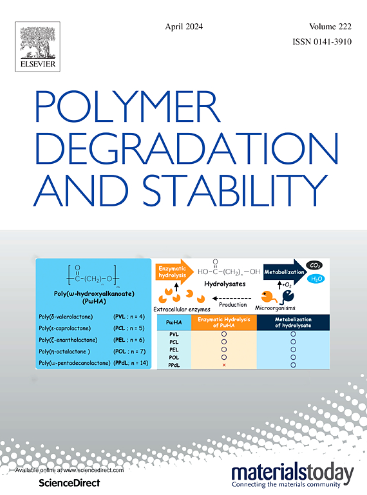Blending recycled poly(lactic acid) (PLA) with elastane recovered from textile fibers: A sustainable valorization approach
IF 6.3
2区 化学
Q1 POLYMER SCIENCE
引用次数: 0
Abstract
The recycling of elastane from textile waste and its reintegration into polymeric matrices represents a possible pathway towards the achievement of a real circular economy in the textile industry. This study investigates the dissolution and recovery of elastane using environmentally friendly solvents and its subsequent blending with recycled poly(lactic acid) (PLA). Among tested solvents, dimethyl sulfoxide (DMSO) was the most effective, dissolving elastane at 120 °C with a solubility limit of 40.77 mg EL/g DMSO at 160 °C. Recovery via non-solvent induced phase separation (NIPS) allowed for 75–80 % solvent recovery, with residual DMSO reduced down to 5–6 % after drying.
Blends of recycled PLA with recovered elastane (5–15 wt.%) were produced via melt extrusion and evaluated for mechanical and thermal properties. Tensile tests revealed that adding elastane reduced the elastic modulus (from 3.52 GPa for PLA to 3.14 GPa for PLA+15) while increasing elongation at break. However, tensile strength declined due to poor interfacial adhesion between PLA and elastane. Dynamic mechanical thermal analysis (DMTA) confirmed elastane’s limited compatibility with PLA, showing separate glass transition temperatures at ∼60 °C (PLA) and ∼10 °C (elastane). Differential scanning calorimetry (DSC) indicated an increase in PLA crystallinity (from 19.5 % for PLA to 24.9 % for PLA+5), followed by stabilization around 20.7 % at higher elastane content. Scanning electron microscopy (SEM) revealed elastane dispersion within the PLA matrix, with droplet coalescence at higher elastane concentrations.
Despite its limited compatibility, this study highlights the potential for elastane to have a second life and demonstrates the feasibility of incorporating it into recycled PLA. It lays the foundation for future research on compatibilization strategies to improve mechanical performance.
混合再生聚乳酸(PLA)与从纺织纤维中回收的弹性烷:一种可持续的增值方法
从纺织废料中回收弹性烷并将其重新整合到聚合物基质中,是实现纺织工业真正循环经济的可能途径。本研究探讨了使用环保溶剂对弹性烷的溶解和回收,以及随后与再生聚乳酸(PLA)的共混。在所测试的溶剂中,二甲亚砜(DMSO)对弹性烷的溶解效果最好,在120°C时,DMSO的溶解度极限为40.77 mg EL/g。通过非溶剂诱导相分离(NIPS)回收,允许75 - 80%的溶剂回收率,干燥后残留的DMSO减少到5 - 6%。回收PLA与回收弹性烷(5-15 wt.%)的共混物通过熔融挤出生产,并评估了机械和热性能。拉伸试验表明,加入弹性烷降低了PLA的弹性模量(从PLA的3.52 GPa降低到PLA+15的3.14 GPa),同时增加了断裂伸长率。然而,由于PLA与弹性烷之间的界面粘附性差,拉伸强度下降。动态机械热分析(DMTA)证实了弹性橡胶与PLA的有限相容性,显示出分别在~ 60°C (PLA)和~ 10°C(弹性橡胶)的玻璃化转变温度。差示扫描量热法(DSC)显示PLA的结晶度增加(从PLA的19.5%增加到PLA+5的24.9%),然后在较高的弹性烷含量下稳定在20.7%左右。扫描电子显微镜(SEM)显示弹性烷在PLA基体内分散,在较高的弹性烷浓度下液滴聚结。尽管其兼容性有限,但本研究强调了弹性烷具有第二生命的潜力,并证明了将其纳入回收PLA的可行性。为进一步研究提高材料力学性能的增容策略奠定了基础。
本文章由计算机程序翻译,如有差异,请以英文原文为准。
求助全文
约1分钟内获得全文
求助全文
来源期刊

Polymer Degradation and Stability
化学-高分子科学
CiteScore
10.10
自引率
10.20%
发文量
325
审稿时长
23 days
期刊介绍:
Polymer Degradation and Stability deals with the degradation reactions and their control which are a major preoccupation of practitioners of the many and diverse aspects of modern polymer technology.
Deteriorative reactions occur during processing, when polymers are subjected to heat, oxygen and mechanical stress, and during the useful life of the materials when oxygen and sunlight are the most important degradative agencies. In more specialised applications, degradation may be induced by high energy radiation, ozone, atmospheric pollutants, mechanical stress, biological action, hydrolysis and many other influences. The mechanisms of these reactions and stabilisation processes must be understood if the technology and application of polymers are to continue to advance. The reporting of investigations of this kind is therefore a major function of this journal.
However there are also new developments in polymer technology in which degradation processes find positive applications. For example, photodegradable plastics are now available, the recycling of polymeric products will become increasingly important, degradation and combustion studies are involved in the definition of the fire hazards which are associated with polymeric materials and the microelectronics industry is vitally dependent upon polymer degradation in the manufacture of its circuitry. Polymer properties may also be improved by processes like curing and grafting, the chemistry of which can be closely related to that which causes physical deterioration in other circumstances.
 求助内容:
求助内容: 应助结果提醒方式:
应助结果提醒方式:


